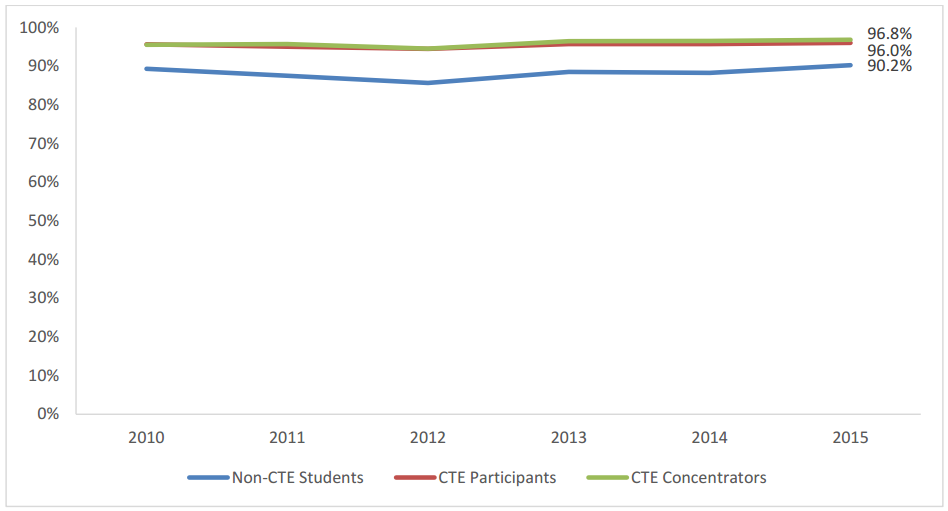In 2015, the most recent year data are available, CTE students nationwide graduated at a rate of 93 percent — approximately 10 percentage points higher than the average. Now, new research from Wisconsin and Washington adds to the growing body of evidence that secondary Career Technical Education (CTE) leads to positive postsecondary outcomes.
State Research Shows Positive Outcomes for CTE Students
 The Public Policy Forum, a research organization based out of Milwaukee, recently published a report examining the CTE system in both Wisconsin and the local Milwaukee region. The study draws upon Wisconsin’s CTE Enrollment Reporting System (CTEERS) and district-level surveys of CTE graduates and finds that two-thirds of students in Wisconsin enroll in CTE courses. The most popular area of focus for these students was Business & Information Technology. The study also revealed positive outcomes for CTE students, including:
The Public Policy Forum, a research organization based out of Milwaukee, recently published a report examining the CTE system in both Wisconsin and the local Milwaukee region. The study draws upon Wisconsin’s CTE Enrollment Reporting System (CTEERS) and district-level surveys of CTE graduates and finds that two-thirds of students in Wisconsin enroll in CTE courses. The most popular area of focus for these students was Business & Information Technology. The study also revealed positive outcomes for CTE students, including:
- CTE Concentrators were six percentage points more likely to graduate from high school than non-participants.
- Approximately 74 percent of CTE Concentrators went on to pursue further education, with about one-third attending a 2-year school and two-thirds attending a 4-year school.
- Of those attending higher education, 72 percent reported pursuing fields of study related to their high school CTE courses.
However, the data revealed inconclusive results related to performance on academic assessments. Additionally, the report identified a 6.3 percent statewide decrease in CTE teaching assignments from 2009 to 2016 — a trend the state has been working to reverse through recent legislation making it easier for CTE teachers to get certified in the state.
Washington Audit Highlights CTE Student Achievement
A report from the Washington State Auditor’s Office examines outcomes data for students in both the 2012 and 2013 graduating high school classes and finds that secondary CTE students demonstrated high post-high school achievement. The study was commissioned to examine the impact of Washington state’s $400 million investment in CTE — a system that reaches 300,000 high school students statewide.
 The study finds that, within the population of students that did not go on to a four-year degree, CTE students were 11 percent more likely to “achieve” than non-CTE students. According to the study, “achievement” is measured as persistence in apprenticeship programs, persistence in community and technical colleges, employment and certificate attainment. Additionally, CTE programs accommodated a higher proportion of students receiving free and reduced price lunch and students with disabilities than other non-CTE programs, indicating that CTE could be a strategy for students of all socioeconomic backgrounds and abilities to acquire the skills needed for high-demand, high-wage careers.
The study finds that, within the population of students that did not go on to a four-year degree, CTE students were 11 percent more likely to “achieve” than non-CTE students. According to the study, “achievement” is measured as persistence in apprenticeship programs, persistence in community and technical colleges, employment and certificate attainment. Additionally, CTE programs accommodated a higher proportion of students receiving free and reduced price lunch and students with disabilities than other non-CTE programs, indicating that CTE could be a strategy for students of all socioeconomic backgrounds and abilities to acquire the skills needed for high-demand, high-wage careers.
Austin Estes, Policy Associate

